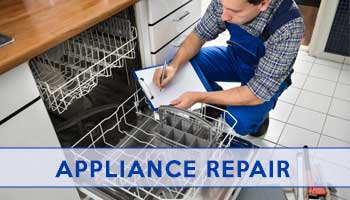Property Managers Rely On Dependable Refrigeration & Appliance Repair Service Sub-Zero Appliance Repair
Property Managers Rely On Dependable Refrigeration & Appliance Repair Service Sub-Zero Appliance Repair
Blog Article
The Ultimate Guide to DIY Home Appliance Fixing Techniques
From refrigerators to dishwashers, comprehending exactly how to fix and fix these tools can conserve you time and cash. Are you all set to uncover important methods that will equip you to deal with repair services with confidence?
Understanding Common Device Issues
When you rely on your home devices, it can be annoying when they unexpectedly quit working or act up. Understanding common home appliance problems can assist you fix issues properly.
If your oven isn't home heating, defective components or thermostat issues could be to condemn,. Dishwashers usually experience problems with drainage, so ensure the filter is clean and the drainpipe hose pipe isn't kinked.
Additionally, pay attention for uncommon audios; they commonly suggest mechanical problems. By recognizing these indicators, you can conserve time and potentially avoid costly repair services. A little expertise goes a long way in keeping your devices, so stay informed to maintain everything running smoothly.
Crucial Devices for Do It Yourself Repair Works
Prior to diving right into DIY device repair work, it's important to gather the right tools to assure the process goes smoothly. Beginning with a great collection of screwdrivers, including both flathead and Phillips, as they're essential for opening most appliances. You'll additionally desire a pair of pliers for gripping and twisting cords or little elements.
Don't fail to remember a multimeter; it aids you examination electric elements and identify issues properly. An outlet collection comes in handy for loosening up or tightening screws, while an energy knife can be beneficial for opening up or cutting cables packaging.
Ultimately, consider having a flashlight available to light up dark spaces inside your devices. With these important devices, you'll be fully equipped to deal with different fixings, conserving both time and cash. So, collect your gear and prepare to roll up your sleeves!
Safety And Security First: Safety Measures to Take
Prior to you start any kind of home appliance repair work, it's necessary to prioritize safety and security. Ensure you wear personal safety equipment, disconnect the power resource, and keep your workplace organized. These simple preventative measures can aid prevent mishaps and ensure a smoother repair work process.

Personal Protective Tools
Security gear is a crucial part of any kind of do it yourself home appliance repair task. You need to constantly wear safety goggles to protect your eyes from dirt and particles. A sturdy set of gloves will secure your hands from dangerous materials and sharp edges. Consider making use of a mask if you're taking care of chemicals or dust, ensuring you take a breath securely while functioning. Steel-toed boots are additionally a smart option, especially when lifting hefty home appliances. Do not forget to use long sleeves and pants to secure your skin from potential injuries. By focusing on personal protective devices, you'll considerably minimize the danger of injuries and crashes. Remember, being prepared with the best gear keeps you safe and concentrated on finishing your repair service efficiently.
Power Source Interference
To guarantee a safe DIY device repair, separating the source of power is important. Prior to you start any work, you ought to disconnect the appliance or transform off the breaker. This simple step prevents electrical shocks and warranties that you can concentrate on the repair service without stressing over unintended activation. Constantly confirm that the home appliance is off by examining it with a voltage tester. If you're taking care of bigger home appliances, like a washing machine or clothes dryer, see to it to safeguard the power cable and prevent any kind of contact with water. Remember, safety and security initially! As soon as you're positive that the power is disconnected, you can confidently wage your repairs, recognizing you've taken the required safety measures to protect on your own.
Work Area Organization
A well-organized workspace can make all the distinction in your DIY home appliance repair service task. Beginning by removing your work space of mess to avoid accidents and disturbances. Outline all your tools and products, grouping similar items with each other for easy accessibility. Utilize a tool kit or organizer to keep tiny parts like washers and screws contained and labeled. Make certain you have actually got appropriate illumination; it'll help you see details plainly and minimize the danger of mistakes. Don't neglect to maintain safety and security equipment like handwear covers and safety glasses accessible. Have a garbage bag handy to dispose of waste promptly. A neat area not just improves effectiveness but additionally maintains you risk-free while you work on your home appliance repair service.
Step-by-Step Guide for Fridge Fixes
When your refrigerator begins acting up, it can be irritating, but taking on the problem on your own can conserve you time and cash. Disconnect the fridge to assure security. Look for common issues like temperature level fluctuations or uncommon noises. Inspect the thermostat setups; they could be established also high if it's not cooling down. Next, tidy the condenser coils, which usually gather dirt and debris. For a loud fridge, check the fan and validate it's not obstructed.
If there's water pooling inside, check the door seals for damages or dust, and tidy them if essential. For ice build-up, clear the defrost drain. Connect the refrigerator back in and check it for a couple of hours when you have actually resolved the issue. If the problem persists, you may need to change a faulty part, like the compressor or follower motor. Remember, don't wait to speak with the manual or look for specialist assistance if required.
Dealing With Cleaning Equipment Concerns
Just like fridges, washing machines can provide their own collection of difficulties, however numerous issues can be resolved with a little troubleshooting. If your device will not begin, check the power cable and verify it's plugged in. Next, evaluate the door latch; a damaged latch can avoid the cycle from starting. If you observe uncommon noises during procedure, it may be due to foreign items embeded the drum or the drainpipe pump.
Tightening up these can frequently address the issue. Routine upkeep, like cleaning up the filter, can protect against lots of concerns from developing.
Fixing Stoves and stoves
How can you repair usual issues with your oven or stove? Start by checking the power supply. Ensure it's plugged in and the breaker is not tripped. If it's a gas range, validate the gas shutoff is open. Next off, test the burners: if they do not fire up, clean up the igniter and look for obstructions in the heater ports.
If your oven isn't heating, check the temperature level setups and verify the door exhaust fan repair seals tightly. If it's harmed., a defective heating component might additionally be the perpetrator; you might need to change it.
For uneven food preparation, turn your pans and consider making use of a stove thermometer to verify exact temperatures. Finally, if you hear uncommon noises or odor gas, shut off the home appliance right away and get in touch with an expert. By following these steps, you can recognize and resolve numerous typical stove and cooktop issues effectively.
Fixing Dish Washers Made Easy
When your dish washer starts acting up, it can be aggravating, however resolving common problems isn't as difficult as it appears. You'll learn step-by-step troubleshooting techniques that will certainly aid you determine the trouble, along with the vital devices you'll require to take on repairs on your own. Allow's make repairing your dishwasher a wind!
Usual Dishwasher Issues
While dishwashing machines fix refrigerator are created to make your life less complicated, they can occasionally run right into common issues that leave you really feeling frustrated. One frequent issue is inadequate cleansing efficiency; this often occurs as a result of clogged spray arms or dirty filters. You may additionally see water merging at the bottom, which can indicate a kinked hose or a malfunctioning drainpipe. It can be a straightforward problem with the latch device or door seal if your dishwashing machine's door won't latch. In addition, odd noises can signify loosened parts or damaged elements. Ultimately, if you scent something strange, it may be time to look for food debris or a malfunctioning motor. Addressing these issues early can conserve you time and problem later on (Dependable Refrigeration & Appliance Repair Service).

Detailed Troubleshooting
Before diving right into repairs, it's vital to determine the particular problem your dishwashing machine is facing. If your dishwasher won't begin, examine the power supply and door lock. By carefully addressing each potential problem, you can identify the issue and take the essential steps to repair it, making your dishwasher feature like new once more.
Vital Repair Service Devices
Having the right devices at your disposal can make all the distinction when repairing your dishwasher. Do not fail to remember a bucket or towels for any kind of water splashes during repairs.
You could likewise want a level to assure your click to investigate dishwashing machine's properly lined up. With these essential tools, you'll be well-appointed to deal with any kind of dishwasher repair service challenge that comes your method.
Regularly Asked Questions
Exactly how Do I Determine if an Appliance Deserves Fixing?
To figure out if a device's worth fixing, consider its age, repair work expenses, and existing value. You may desire to spend in a brand-new model instead - Best Sub-Zero Service Near You Dependable Refrigeration & Appliance Repair Service. if repairs exceed half the replacement price.
Can I Locate Substitute Components Locally for My Home Appliance?
Yes, you can typically discover replacement parts locally for your device. Examine equipment stores, appliance repair work shops, or local classifieds. Do not neglect to bring the design number to ensure you get the correct component!
What Usual Mistakes Should I Stay Clear Of When Repairing Appliances?
When repairing appliances, stay clear of rushing through diagnostics, ignoring safety and security preventative measures, or using wrong devices. Don't miss checking out manuals or watching tutorials; they give necessary assistance. Hold your horses and thorough to assure successful repairs and stop further damages.
For how long Does a Normal DIY Device Repair Work Take?
A typical do it yourself home appliance fixing normally takes one to three hours, relying on the complexity. You'll wish to gather your products and tools first, and follow guidelines thoroughly to stay clear of unnecessary hold-ups.
Are There Any Type Of Service Warranties for DIY Device Repairs?
When you deal with do it yourself home appliance fixings, warranties commonly don't cover your work. However, some makers could honor guarantees for components you replace. Constantly check your home appliance's service warranty terms before beginning any kind of repairs to prevent issues.
Before diving into Do it yourself appliance repair services, it's vital to gather the right devices to assure the procedure goes smoothly.Before you start any kind of appliance repair work, it's necessary to focus on safety.To guarantee a risk-free Do it yourself appliance repair work, separating the power source is vital.An efficient work area can make all the distinction in your DIY home appliance fixing task. Always check your appliance's service warranty terms prior to beginning any kind of repairs to avoid problems.
Report this page